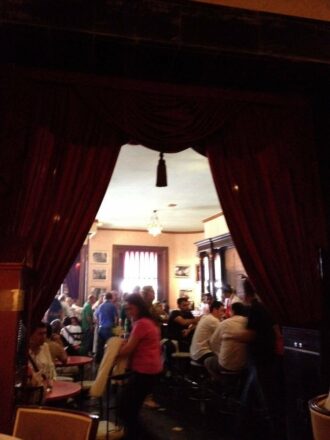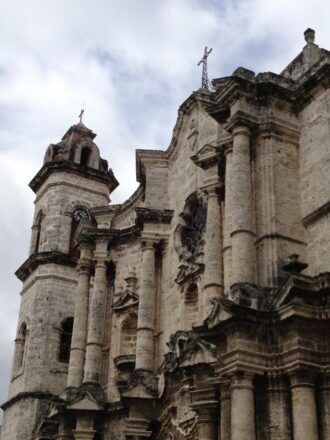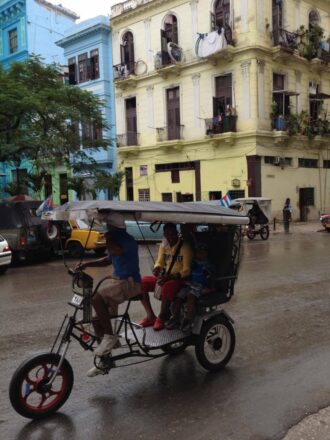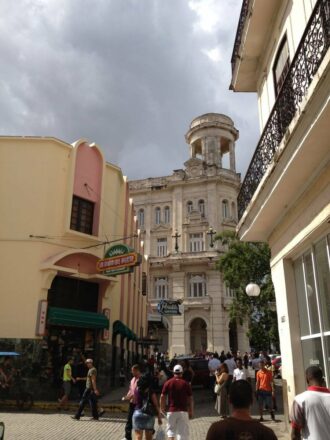It occurred to me I really should speak to renowned Cuban-born New York designer Vicente Wolf about Cuba – how it has influenced him as a designer and how Cuba has inspired him. Graciously he obliged. His answers, which might have surprised me before I went there myself last week, do not surprise me now.

“I left Havana at 15,” he begins, so I remember it very clearly. Still in my mind I walk the streets.

We lived in Old Havana – in what one would call a penthouse today. Our kitchen window overlooked Morro Castle.”

Old Havana, or Habana Vieja as the Cubans call it, is also where we lodged during our four-day stay at the Hotel Parque Central, a siren-calling stone’s throw from El Floridita, one of Ernest Hemingway’s old watering holes and “the cradle of the daiquiri.” I don’t generally think of daiquiris in cradles, except that you might need one if you’ve had too many.

Anyway, we did walk the streets, some of them cobblestone and some paved (astonishingly) with wooden blocks to lessen the noise of the carriage wheels and horses’ hooves.

Old Havana’s stunning buildings – some dating from the 16th century when the city was founded by the Spanish – have borne 50-plus years of abuse and neglect. Houses and municipal buildings alike are mostly in various states of decay, walls crumbling and paint peeling as laundry flaps lazily across a noble arched window or an expanse of balcony. Socialism works, as my Senor Tom says; everyone is poor.

And then there are the modern buildings, designed in the first part of the 20th century – until the revolution and ouster of Batista in 1959 – that are exemplary of their respective periods.


“Most Americans don’t realize what a sophisticated city it was,” Vicente says. “It was unlike any other city in Latin America at the time,” he continues, “and the architecture was amazing. There was a very strong architectural community there.”
Clearly, but post-revolution…The Soviet-era architectural atrocities are mostly unspeakable, so I will unspeak of them.
And yes there are a few bright spots of restoration, and in recent years there has been the blessing, albeit non-remunerative, of UNESCO. But Havaneros and their visitors attuned to the worlds of decoration and design are left with what remains: vestiges of beauty and culture courageous in their dignity and tenacious in their survival, but ultimately tragic.


“To me,” said Vicente, “What people find charming, I find sad. It’s as though the city was this beautiful woman and now she’s drunk too much and lived a bad life, and she’s completely gone.”

But the news isn’t all bad. Economic restrictions seem ever so incrementally to be loosening since Fidel ceded power to his brother Raul in 2006, including – this just in! – the brand new beginnings of a real estate market. I’ve just read it in the New Zealand Herald of all places, a good article, too…. Tomorrow, what inspires Vicente about his homeland, and a tour of Ernest Hemingway’s house, outside Havana.


Oh, my, I wish there were more photos! We left Cuba when I was seven years old (many, many years ago). I have memories of going shopping in “La Habana Vieja” with my Mom and Abuela (grandmother) and distinctly remember the cobblestones. I remember a wonderful store called “El Encanto” which means “The Enchantment” and wanting to live there because it had such beautiful, lovely things. I remember family gatherings at our home with the women beautifully dressed and groomed and the men sporting crisply starched guayaberas, the scent of Cuban tobacco and lemony-clean smelling cologne, do not remember the name, but remember it was from Guerlain and the bottle had little bees on it, perfuming the air. I agree with Mr. Wolf, in that it is sad to see what was once beautiful decaying due to neglect. My father used to call Castro the great equalizer, because he made everyone equally miserable. Batista was not perfect, however under his rule there was no continuous, mass exodus as there has been since Castro came into power. Hopefully, one day La Habana and all of Cuba will be free and restored to its long-gone elegance and charm. Thank you for the memories and these two posts on Cuba, although I am American (by choice) and love the U.S. very, very much, I do love seeing my native country through another’s eyes. It is interesting to see what others take away from the experience of visiting modern-day Cuba.
Just returned from amazing Cuba trip. To the individual remembering Cuba, go back and check it out, it’s still beautiful in a sometimes shabby way. The very best part are the people. Go for them! Your travel dollars don’t just benefit the party, they help individuals. Bring some gifts and tips and go see for yourself!
Thank you, J Boyles, couldn’t agree more! Frances